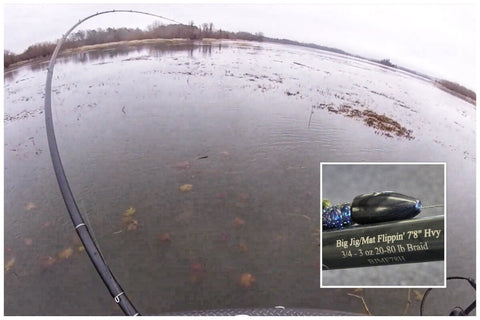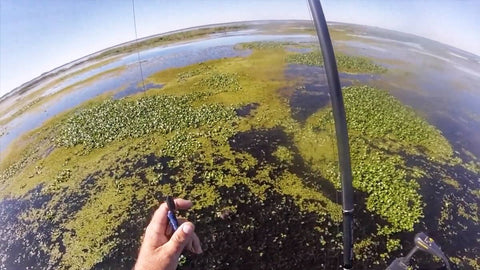By: Shaye Baker
Punching for bass is one of my favorite techniques year-round. Reason being, it’s a great way to catch a big one in any season. I get to tie on a big weight, a big bold hook and spool up the strongest braided line I have on the heaviest duty rod and reel I’ve got. And then initiate close quarters combat with big mean bass under thick and nasty cover. What could be better than that?
The pre-spawn is my favorite time to punch as plump pretty females seek refuge under overhead cover near spawning flats, just hoping to fatten up a bit more before they head to their beds. Then I slide through, dump a 1- and 1/2- ounce weight on their head and snatch them in the boat before they even know what hit them. It’s really pretty special.
But perhaps the most important time to know how to punch is in the fall. Bass fishing can be pretty tough in the fall. The changing water temps, fall turnover, fluctuating oxygen levels and abundance of bait can make fishing tough at times. Bites are often few and far between and one big bite can go a long way whether you’re fishing in a tournament or just trying to keep up morale while fishing for fun.

Best Punching Rod for Bass
“You don’t go bear hunting with a switch”. That’s something my dad has said all my life (and I’m sure he probably picked it up from someone else), but it is very relevant when discussing rod selection for punching. You’re putting a bait in the nastiest and thickest stuff you can find and hoping to haul out a 6-pound bass or bigger! If you don’t pick a big enough rod, hoping will be all you’re doing.
I personally flip with a 7’ 8” Heavy Big Jig/Mat Flippin’ rod from Fitzgerald Fishing. But don’t let the heavy in the name fool you. This rod is as strong as what you’ll see listed as an extra or even extra-extra heavy action by some other companies.
The rod I use also has a somewhat parabolic bend, meaning it doesn’t just bend at the tip but instead the whole rod bends all the way back to the handle. This helps spring the fish out of the matted vegetation when you set the hook. If they don’t come straight out of the mat, the heavy action and long rod makes it easier to keep pressure on them until they do pop through. Plus, a rod this size makes it much easier to boat flip the big ones.

Best Reel Punching for Bass
Like rod selection, the reel and line have to be up for the task. You’ll need a baitcasting reel with a strong drag. Personally, I prefer a longer handle with big paddles that ensure a nice firm grip so that my hand doesn’t slip off the paddles on the hook set. And the longer handle gives you more leverage to turn the reel and winch the fish to the boat.
I also prefer a faster gear ratio reel so that I can’t burn my bait back between flips and cover more water. But you want to make sure you don’t compromise strength for speed, as some reels become weaker the higher their gear ratio goes. The best reel I’ve found to suit all these requirements is a Lew’s Super Duty Speed Spool in 7.5:1 gear ratio. This gives me plenty of power, speed, and control.

Line Selection When Punching for Bass
Spooling the reel with the right line matters immensely. For punching, nothing short of 65-pound braid will do. There are instances in sparser cover when 50-pound might be sufficient, but there’s really no upside to downsizing your line here. The 50-pound test is just as visible as the 65-pound test and inevitably you’ll end up coming across a particularly thick patch of cover. When you flip in there with the 50-pound, you’re setting yourself up for failure when you hook a big bass— which is the main point of punching.
On the flip side, some anglers go all the way up to 70 and even 80-pound test. I think this is unnecessary, but I really don’t have a problem with bigger line like I do with downsizing to something less than 65-pound. If you have more confidence in 80, then go with 80. But I’ve hauled several 6 to 9-pound bass out of extremely thick cover with 65-pound Sufix 832 Braid and never once had an issue.

Best Punch Rig Setup for Bass
Best Hooks for Punching for Bass
For the hook, you’ll want a stout and strong 4/0 flipping hook. A 3/0 is a little too small. You could use a 5/0 if you’d like, but the 4/0 slips through the cover a little easier and increasing your efficiency as much as possible is crucial when punching. Similarly, if a 1-ounce weight makes it through the mat almost every time, stick with it. But if it’s getting hung up or not going through clean for most of your flips, then up your size to a 1½-ounce.
Best Weight Punching for Bass
I have punched with as heavy as a 2½-ounce tungsten weight before. That size will punch through a mat that’s about as dense as a car hood. I typically use a rubber peg to secure all my punching weights in place. I used to use a bobber stopper above the weight, but the weight would beat on the nose of the bait and I’d end up going through more soft plastics than necessary. I was also less efficient getting through the mats. Pegging the weights keeps them from sliding up or down the line, so you can lock it in just above the nose of the bait.
Best Punch Baits for Bass
As far as baits go, you want something again that will go through clean. Picking something small that will cover the hook well is usually enough. I’ve caught some of the biggest fish I’ve ever caught punching a BB Cricket from Gambler Lures. It quite literally is just big enough to cover the hook point. But my standard go to bait is a MISSILE Baits D-Bomb. The D-Bomb is a creature style bait that works well in thick cover as well as sparse cover, so it’s a good bait to have on and pitch at whatever is in front of you.

What To Look for When Punching for Bass
In the fall, pretty much any cover you can find that’s creating a canopy is the deal. That may be matted hydrilla that has topped out and covered the surface. Or perhaps you’re fishing in an area with a lot of current or boat traffic and a decent amount of vegetation has been torn loose from the bottom. In that case you’ll likely find mats of floating vegetation pushed together. I’ve even heard of people catching fish through sawdust and pine straw mats.
Pretty much anything that’s matted up along the surface is likely to have a fish under it in the fall. The fish tend to be in a funky mood and often like to bury up in cover and rest. Hydrilla, coontail and milfoil also top out in the summer and as the fall comes along, cavities are created underneath the mats. This makes for great frogging and punching conditions along miles of grass mats on lakes like Guntersville in Alabama up to Champlain in Vermont and all the way out to the California Delta.

Having the right gear is absolutely essential if you’re planning to go punching. A big and strong rod paired with a fast and powerful reel is a must. Add to that 65-pound test or stronger braided line and you’re halfway home. Something like a 4/0 VMC Heavy Duty Flippin’ Hook works best. Pair that with a 1½-ounce tungsten flipping weight and a quality soft plastic creature bait and you’ve got a combo that can handle 90% of what’s out there.
Look for sparse to thick matted vegetation or other floating cover. You may catch a bass out of a pile of leaves and pine straw, or one out of a windblown mat of floating eel grass. The most important thing isn’t typically the type of cover in the fall, but instead to just put a punching rod in your hand and flip whatever is in front of you on your particular body of water. If you do that, you’re bound to get a bite and tie into a big one.
← Older Post Newer Post →


